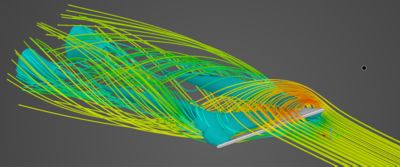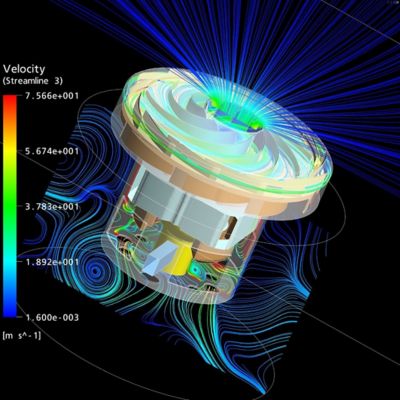Case Study
-
United States -
United Kingdom -
India -
France -
Deutschland -
Italia -
日本 -
대한민국 -
中国 -
台灣
-
Ansys is committed to setting today's students up for success, by providing free simulation engineering software to students.
-
Ansys is committed to setting today's students up for success, by providing free simulation engineering software to students.
-
Ansys is committed to setting today's students up for success, by providing free simulation engineering software to students.
-
Contact Us -
Careers -
Students and Academic -
For United States and Canada
+1 844.462.6797
“Through hands-on experience with Ansys Discovery software, Ansys Fluent simulation, and the Ansys CFX solution in both introductory and advanced CFD classes for bachelor's and master's students, we bridge theoretical learning with practical application. This approach not only enhances course satisfaction, but also deepens understanding of fundamental concepts such as boundary conditions, grid studies, accuracy, time-step selection, and turbulence models. Ultimately, students gain proficiency in solving real-world computational fluid dynamics (CFD) challenges, preparing them for successful careers as engineers in the industry.”
— Philipp Epple, Prof. Dr. -lng., Coburg University of Applied Sciences
Today, theoretical classes in CFD must be complemented with practical exercises using a Navier-Stokes solver. Coburg University of Applied Sciences in Coburg, Germany, offers CFD classes for bachelor’s and master’s students, along with advanced master’s classes. In the introductory classes, the fundamental theory covers the derivation of Navier-Stokes equations and a thorough understanding of each of its terms, the analytical solutions of fundamental flows (as in the flow in pipes or over a flat plate), the derivation of RANS equations, and the discussion of turbulent stresses and turbulence models.
This theory is accompanied with hands-on CFD classes that involve learning workflows with Ansys Workbench™ simulation integration platform and Ansys CFX® CFD software, including geometry generation, mesh creation, boundary condition setting, grid refinement, and turbulence model selection.

Figure 1. Prof. Dr.-Ing. Philipp Epple teaches CFD at Coburg University of Applied Sciences.
Challenges
To learn CFD, hands-on experience with Navier-Stokes solvers like Ansys Discovery™ 3D product simulation platform, Ansys Fluent® fluid simulation software, and CFX software is crucial.
The challenge of CFD lectures is to teach the theory (i.e., derive the fundamental equations, continuity, momentum, and energy equations); practice with these equations; teach discretization methods, finite differences and finite volumes to solve these equations numerically; and enable the students to solve real-world CFD problems.
In mechanical engineering, students must learn how to solve complex flow problems and to perform real-world product development and optimization in fluid mechanics. This can only be accomplished with professional CFD software. Discovery software, Fluent software, and CFX software are used for this purpose in teaching, as these are state-of-the art software packages used in industry and academia.

Figure 2. Simulation of the flow around a delta wing with Discovery software

Figure 3. Flow visualization around a delta wing
Engineering Solutions
The CFD classes are divided into theoretical classes and practical classes using Ansys. In the practical classes, it is important that students learn the whole workflow: generating or impoting geometry, generating and studying grids, setting up boundary conditions and monitor points, selecting the time step and turbulence model, and solving and post-processing the solution using visualization features like contour plots, stream lines, and vector plots. In addition to this, students learn how to perform quantitative post-processing and export the quantitative results to CSV files. With Discovery software, the students learn:
- How to explore different flows, like the flow around a cylinder, airfoil, or pipe
- How to change and immediately see the effects of the boundary conditions and geometry modifications

Figure 4. Simulation of the flow through a vacuum cleaner fan with CFX software

Figure 5. Coburg University of Applied Sciences
Additionally, students gain hands-on experience with Ansys Meshing™ 2D/3D mesh generation and analysis capability, Ansys TurboGrid™ turbine blade meshing software, and the ICEM capability for generating various grid types and refining grids based on theoretical concepts. Practical applications include uncertainty estimation via Richardson extrapolation in CFX software, studying turbulence model impacts with the backward-facing step, and simulating rotating frames of reference with axial and radial fans.
Benefits
When solving complex and real-world simulation problems, CFD classes have a theoretical part that is necessary in understanding CFD and writing code. However, to meet industry and academia requirements, engineering simulation is needed. Therefore engineering simulation using Discovery software, Fluent simulation, and the CFX tool is included in classes. The software helps students develop an understanding in fundamental and complex flows. For example, students learn how to understand the differences between incompressible and compressible flows at subsonic and supersonic velocities. Additionally, students learn how to solve real-world problems in fluid mechanics, such as the flow over airfoils, cars, or an entire aircraft, as well as the flow through turbomachines.
Let’s Get Started
If you're facing engineering challenges, our team is here to assist. With a wealth of experience and a commitment to innovation, we invite you to reach out to us. Let's collaborate to turn your engineering obstacles into opportunities for growth and success. Contact us today to start the conversation.











